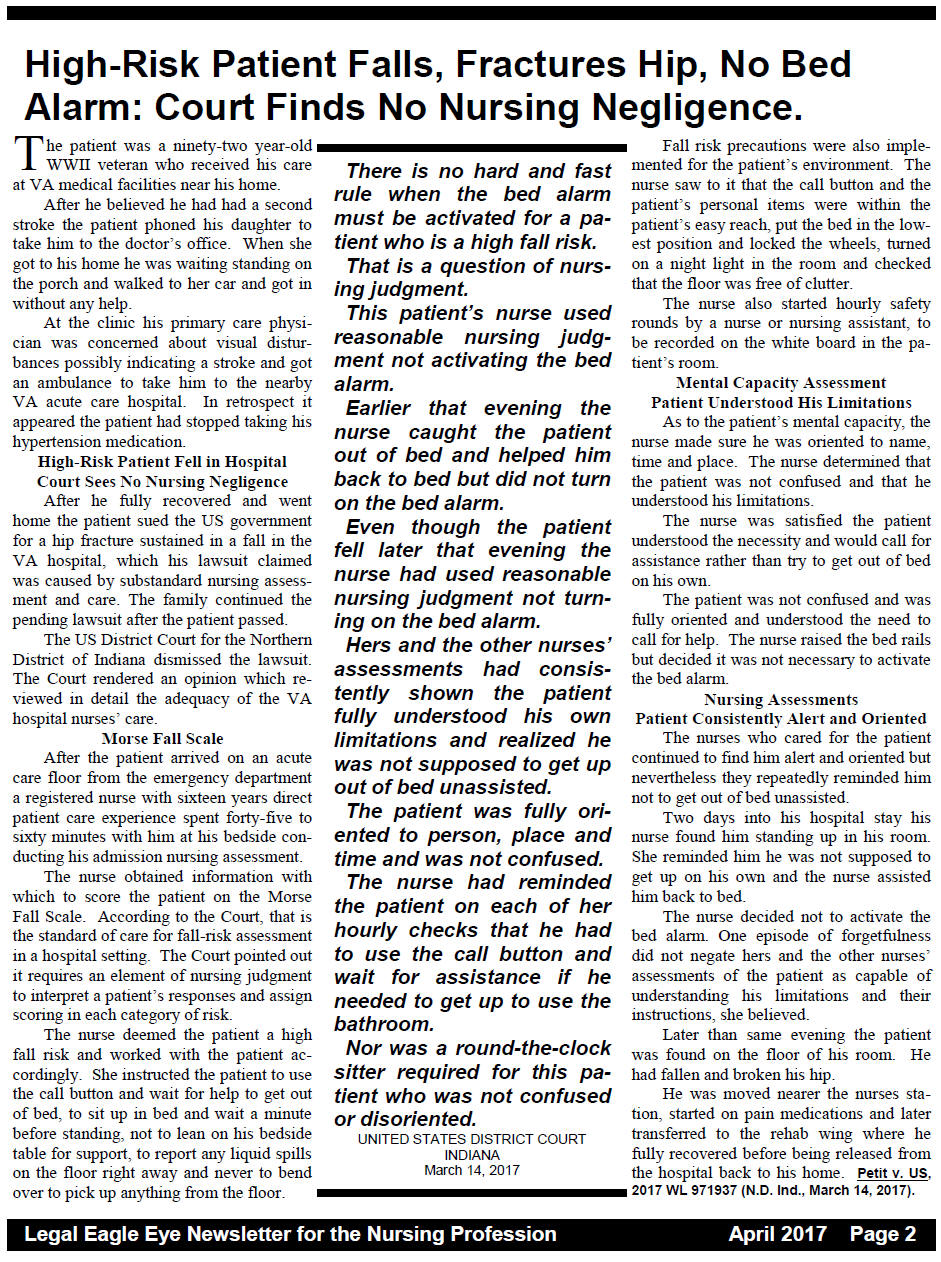
Legal Eagle Eye Newsletter for the Nursing Profession Home Page
New Subscriptions I About Our Newsletter I Sample Newsletter I FAQ I Contact Us

High-Risk Patient Falls, Fractures Hip, No Bed Alarm: Court Finds No Nursing Negligence.
There is no hard and fast rule when the bed alarm must be activated for a patient who is a high fall risk. That is a question of nursing judgment.
This patient's nurse used reasonable nursing judgment not activating the bed alarm. Earlier that evening the nurse caught the patient out of bed and helped him back to bed but did not turn on the bed alarm. Even though the patient fell later that evening the nurse had used reasonable nursing judgment not turning on the bed alarm.
Hers and the other nurses' assessments had consistently shown the patient fully understood his own limitations and realized he was not supposed to get up out of bed unassisted. The patient was fully oriented to person, place and time and was not confused. The nurse had reminded the patient on each of her hourly checks that he had to use the call button and wait for assistance if he needed to get up to use the bathroom. Nor was a round-the-clock sitter required for this patient who was not confused or disoriented.
UNITED STATES DISTRICT COURT INDIANA March 14, 2017The patient was a ninety-two year-old WWII veteran who received his care at VA medical facilities near his home. After he believed he had had a second stroke the patient phoned his daughter to take him to the doctor's office. When she got to his home he was waiting standing on the porch and walked to her car and got in without any help. At the clinic his primary care physician was concerned about visual disturbances possibly indicating a stroke and got an ambulance to take him to the nearby VA acute care hospital. In retrospect it appeared the patient had stopped taking his hypertension medication.
After he fully recovered and went home the patient sued the US government for a hip fracture sustained in a fall in the VA hospital, which his lawsuit claimed was caused by substandard nursing assessment and care. The family continued the pending lawsuit after the patient passed. The US District Court for the Northern District of Indiana dismissed the lawsuit. The Court rendered an opinion which reviewed in detail the adequacy of the VA hospital nurses' care.
After the patient arrived on an acute care floor from the emergency department a registered nurse with sixteen years direct patient care experience spent forty-five to sixty minutes with him at his bedside conducting his admission nursing assessment. The nurse obtained information with which to score the patient on the Morse Fall Scale. According to the Court, that is the standard of care for fall-risk assessment in a hospital setting. The Court pointed out it requires an element of nursing judgment to interpret a patient's responses and assign scoring in each category of risk. The nurse deemed the patient a high fall risk and worked with the patient accordingly. She instructed the patient to use the call button and wait for help to get out of bed, to sit up in bed and wait a minute before standing, not to lean on his bedside table for support, to report any liquid spills on the floor right away and never to bend over to pick up anything from the floor.
Fall risk precautions were also implemented for the patient's environment. The nurse saw to it that the call button and the patient's personal items were within the patient's easy reach, put the bed in the lowest position and locked the wheels, turned on a night light in the room and checked that the floor was free of clutter. The nurse also started hourly safety rounds by a nurse or nursing assistant, to be recorded on the white board in the patient's room.
As to the patient's mental capacity, the nurse made sure he was oriented to name, time and place. The nurse determined that the patient was not confused and that he understood his limitations. The nurse was satisfied the patient understood the necessity and would call for assistance rather than try to get out of bed on his own. The patient was not confused and was fully oriented and understood the need to call for help. The nurse raised the bed rails but decided it was not necessary to activate the bed alarm.
The nurses who cared for the patient continued to find him alert and oriented but nevertheless they repeatedly reminded him not to get out of bed unassisted. Two days into his hospital stay his nurse found him standing up in his room. She reminded him he was not supposed to get up on his own and the nurse assisted him back to bed. The nurse decided not to activate the bed alarm. One episode of forgetfulness did not negate hers and the other nurses' assessments of the patient as capable of understanding his limitations and their instructions, she believed.
Later than same evening the patient was found on the floor of his room. He had fallen and broken his hip. He was moved nearer the nurses station, started on pain medications and later transferred to the rehab wing where he fully recovered before being released from the hospital back to his home.
Petit v. US, 2017 WL 971937 (N.D. Ind., March 14, 2017).More references from nursinglaw.com
http://www.nursinglaw.com/patient-fall-standard-of-care.htm
http://www.nursinglaw.com/patient-fall-wheelchair.htm
http://www.nursinglaw.com/patient-fall-nurses-charting.htm
http://www.nursinglaw.com/patient-fall-care-plan.htm